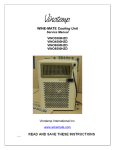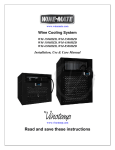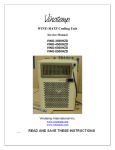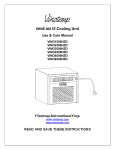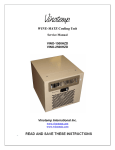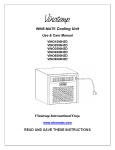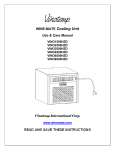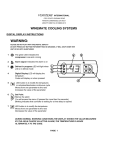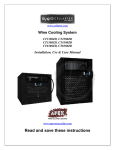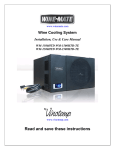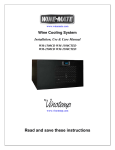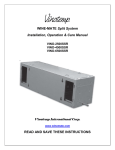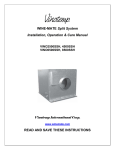Download Vinotemp WINE-MATE WM-65SFCL Service manual
Transcript
WINEMATE Cooling Unit Service Manual WM3500HZD WM4500HZD WM6500HZD WM8500HZD Vinotemp International Inc. www.vinotemp.com SAFETY INFORMATION -1- TABLE OF CONTENTS 1. Introduction………………………………………………..3 I. Goals and Objectives…………………….…...……………………………3 II. R134a Refrigerant Service Information.....................…………..…….3 2. Component Information and Access………………….5 I. Model and Serial Label Location…………………………………………5 II. Component Access…………………………………………………………6 1) Removing the Outer Cover…………………………..……………...…..6 2) Removing the Inner Styrofoam Cover…..……………………………..6 3) Removing the Fan Shroud…………………..…………………………..8 4) Removing the Electronic Controller……………..……………………..9 5) Removing the Thermistor………………………………………………..9 6) Removing Fan Motors…………………………………………………...10 7) Removing the Start Relay and Overload Protector …………….....10 8) Removing the Compressor……..………………………………………11 9) Removing the Condenser……..………………………………………..12 10) Removing the Evaporator…..…………………………………………..12 3. Servicing and Diagnosis……………………………….13 I. Identifying Component Problems........……….…….………………….13 1) Compressor……………………………………………………………….13 2) Start Relay…………………………………………………………………14 3) Overload Protector.………………………………………………………15 4) Electronic Controller……………………………………………………15 5) Thermistor..………………………………………………………………..17 6) Fan Motors.………………………………………………………………..17 II. Wiring Diagram.….……..…………………………………..……………..18 III. Troubleshooting Chart.…....…………….………………………………19 4. Installation and Operation……………………………..21 I. Installation Instructions………..…………………………………………21 II. Operation Information.….………………………………………………..22 5. Customer Support………………………………………24 6. Warranty Information…………………………………..25 I. Limited Warranty …………………………………..……………………..25 II. Limitation of Implied Warranty.………………………………………….26 -2- 1. Introduction VINOTEMP assumes no responsibility for any repairs made on products by anyone other than authorized service technician This manual has been prepared to provide the information on installing, servicing, troubleshooting and repairing procedures for the WINEMATE 3500HZD, 4500HZD, 6500HZD and 8500HZD cooling unit. I. Goals and Objectives The goal of this manual is to provide detailed information that will enable the service personnel to properly install and repair the cooling unit, and troubleshoot and diagnose malfunctions. The objectives of this manual are that the service personnel will • Fully understand the proper safety precautions • Successfully install the cooling unit • Successfully troubleshoot and diagnose malfunctions • Successfully perform necessary repairs • Successfully return the cooling unit to proper operational status II. R134a Refrigerant Service Information This cooling unit uses R134a refrigerant. This refrigerant requires synthetic ester oil in the compressor. This cooling system does not tolerate contamination from any of the following: • • • • • • • • Other refrigerants Moisture Petroleum-based lubricants Silicone lubricants Cleaning components Rust inhibitors Leak detection dyes Any other types of additive As a result, the following precautions should be observed: • • Use equipment dedicated to R134a sealed system only. Use R134a refrigerant for back-flushing. -3- • • • • • • • Use dry nitrogen to purge the system. Do not overcharge the refrigeration system. Do not leave replacement compressor open to the atmosphere for more than 10 minutes. Do not operate the compressor without refrigerant charge in the system. Do not use the compressor if the rubber plugs on the replacement compressor appear to have been tampered or removed. Always replace the filter-drier when performing any repairs on the sealed system. The filter-drier must be cut from the sealed system. Never unbraze the filter-drier from system tubing. Applying heat will drive moisture back into sealed system. Table 1-1 Health and Safety Handling of R134a Allowable Overall Exposure Limit 1,000 ppm Vapor Exposure to Skin No Effect Liquid Exposure to Skin Can cause frostbite Vapor Exposure to Eyes Can cause very slight irritation Liquid Exposure to Eyes Can cause frostbite Above Minimum Exposure Limit Can cause asphyxiation, tachycardia and cardiac arrhythmia's. Wear appropriate skin and eye care. Spill Management Combustible sources. Evacuate or ventilate area. May decompose if in contact. Fire and Explosion Hazards Made with flames and heating elements. Container may explode if heated due to pressure rise. Combustion products are toxic. Storage Conditions The procedures/rules for R12 also apply to R134a. Reclaim -4- 2. Component Information and Access This section provides you the component information and access inside the cooling unit. The components and their locations are shown Figures 2-1 through 2-11 below. I. Model Number & Serial Label and Component Locations Label Figure 2-1 -5- II. Component Access 1) Removing the Outer Cover 1. Unplug the WINEMATE cooling unit or disconnect power. 2. Remove the WINEMATE cooling unit from the enclosure. 3. To remove the outer cover, remove all screws from each side and on the top. Figure 2-2 2) Removing the Inner Styrofoam Covers Once the outer cover is removed, this will expose the inner styrofams. The top large Styrofoam cover seals off the condenser and evaporator fan compartments. To gain access to the other components, the styrofoam covers will need to be removed. To separate the top styrofoam covers, a knife can be used to cut along the seam and through the seal. Take care as not to damage any wiring or the styrofoam pieces. -6- Figure 2-3 Figure 2-4 -7- Figure 2-5 3) Removing the Fan Shroud 1. Remove the 4 rivets 2. Disconnect wires 3. Remove the shroud Figure 2-6 -8- 4) Removing the Electronic Controller Figure 2-7 Figure 2-8 1. 2. 3. 4. 5. 6. 7. Unplug the WINEMATE cooling unit or disconnect power. Remove WINEMATE cooling unit from the enclosure opening Remove the top large styrofoam cover. Disconnect all three connectors for the electronic controller. Unsnap the thin plastic cover off the front of the electronic controller. Remove the two screws from the front of the electronic controller. Locate the retainer just inside the front panel going around the outside of the electronic controller. While squeezing both tabs of the retainer, push the electronic controller out of the opening. 5) Removing the Thermistor 1. 2. 3. 4. Unplug the WINEMATE cooling unit or disconnect power. Remove the WINEMATE cooling unit from the enclosure opening. Remover the outer cover. Remove the top large styrofoam cover. -9- 5. Disconnect the thermistor with connector from the electronic controller. 6. Remove the thermistor from the mounting clip on the front of the evaporator. 6) Removing Fans Figure 2-9 The 2 condenser and evaporator fans are attached to the horizontal fan shroud. They are the same and all powered up at the same time. 1. Unplug the WINEMATE cooling unit or disconnect power. 2. Remove the WINEMATE cooling unit from the enclosure opening. 3. Remover the outer cover. 4. Remove the top large styrofoam cover. 5. Disconnect the two wires going to the electrical junction block. 6. Remove the four screws holding the fan to the shroud. 7) Removing the Start Relay and Overload Protector Figure 2-10 - 10 - 1. 2. 3. 4. 5. 6. Unplug the WINEMATE cooling unit or disconnect power. Remove the WINEMATE cooling unit from the enclosure opening. Remover the outer cover. Remove the top large styrofoam cover. Remove the terminal cover from the compressor. Remove the start relay by pulling straight out away from the compressor terminal. 7. Remove the overload protector by pulling straight out away from the compressor terminal. 7) Removing the Compressor 1. 2. 3. 4. 5. 6. 7. 8. Figure 2-11 Unplug the WINEMATE cooling unit or disconnect power. Remove the WINEMATE cooling unit from the enclosure opening. Remover the outer cover. Remove the top and bottom styrofoam covers and the fan shroud. Place piercing valves onto the process tubes and discharge the refrigerant into an approved R134a recovery system. Use a tubing cutter to remove the suction line and discharge line from the compressor. Remove 4 nuts (11mm) from the feet of the compressor. Remove the compressor Note: Any time the sealed system is accessed the filter-drier must be replaced. It is best to cut the drier out of the system, then braze on a new one. - 11 - 9) Removing the Condenser 1. 2. 3. 4. 5. Unplug the WINEMATE cooling unit or disconnect power. Remove the WINEMATE cooling unit from the enclosure opening. Remover the outer cover. Remove the top large styrofoam cover and the inner divider. Place piercing valves onto the process tubes and discharge the refrigerant into an approved R134a recovery system. 6. Use a tubing cutter to remove the hot gas line and liquid line from the condenser. 7. Remove 4 rivets from the condenser. 8. Remove the condenser 10) Removing the Evaporator 1. 2. 3. 4. 5. Unplug the WINEMATE cooling unit or disconnect power. Remove the WINEMATE cooling unit from the enclosure opening. Remover the outer cover. Remove the top large styrofoam cover and the inner divider. Place piercing valves onto the process tubes and discharge the refrigerant into an approved R134a recovery system. 6. Cut the capillary line and suction line from the evaporator. 7. Remove 4 rivets from the evaporator. 8. Remove the evaporator. - 12 - 3. Servicing and Diagnosis This section instructs you how to service each component inside the cooling unit. I. Component Checking 1) Compressor The compressor acts as a pump, forcing refrigerant through the sealed system. A. Resistance Figure 3-1 1. Unplug WINEMATE cooling unit or disconnect power. 2. Remove the terminal cover from the compressor. 3. Remove the start relay and overload protector from the compressor. If wiring is removed from the start relay and/or overload protector, carefully label each wire according to its proper location. 4. Set the ohmmeter scale to the lowest setting. - 13 - 5. Touch and hold one ohmmeter probe to the C (common) terminal, then touch and hold the other probe to the R (Run) terminal. The ohmmeter should show a reading of a few ohms. If not, the compressor is bad. 6. Touch and hold one ohmmeter probe to the C terminal, then touch and hold the other probe to the S (Start) terminal. The ohmmeter should show a reading between ten to twenty ohms. If not, the compressor is bad. 7. Touch and hold one ohmmeter probe to the R terminal, then touch and hold the other probe to the S terminal. The ohmmeter should show a reading of sum of the last two measurements. If not, the compressor is bad. 8. Touch and hold one ohmmeter probe to the C, or R or S terminal, then touch and hold the other probe to the ground on the compressor. The ohmmeter should read infinity. Any resistance indicates a shorted compressor. 9. If the compressor tests ok, but does not start, check start relay, overload protector and live voltage. B. Live Voltage 1. 2. 3. 4. 5. 6. Unplug WINEMATE cooling unit or disconnect power. Remove the terminal cover from the compressor The WINEMATE unit needs to be plugged in and turned on. Locate the terminals on the start relay and the overload protector. Set the voltmeter to the AC 200 scale. Touch and hold one voltmeter probe to the terminal on the start relay, then touch and hold the other probe to the terminal on the overload protector. 7. The voltmeter should show a reading of 115 volts. 8. If the test is good and the compressor does not start, check the start relay, overload protector, and measure the resistance. Figure 3-2 2) Start Relay - 14 - A start relay’s function is to energize and de-energize the compressor’s start winding. The coil of the current type relay is connected in series with the run winding. When current flows through the coil, a magnetic force is produced, pulling the relay plunger up. With the relay plunger up, it connect the start winding and the run winding at the same time and the compressor starts. As the compressor reaches its running speed, there is not enough current flowing through the relay coil to keep the plunger up (because of gravity), the start winding is disconnected. 1. 2. 3. 4. 5. 6. Unplug the WINEMATE cooling unit or disconnect power. Remove the terminal cover from the compressor. Disconnect and remove the relay. Set the ohmmeter scale to the lowest setting. Make sure the relay with the letters “TOP” facing up. Place and hold one ohmmeter probe in one terminal, then place the other ohmmeter probe into the other terminal. The ohmmeter should show an open circuit. If not, the start relay is bad and needs replacing. 7. Turn the relay upside down. 8. Place and hold the ohmmeter probe in one terminal, and place the other ohmmeter probe in the other terminal. The ohmmeter should show zero resistance. If not, the start relay is bad and needs replacing. 9. If the start relay is good, reinstall and reconnect the relay with the letters “TOP” facing up. 3) Overload Protector The overload protector is a bi-metal that protects the compressor. If the compressor gets too hot the overload protector opens and stops the compressor. Once it has cooled the overload protector contacts close. 1. 2. 3. 4. 5. Unplug WINEMATE cooling unit or disconnect power. Remove the terminal cover from the compressor. Disconnect and remove the overload protector Set the ohmmeter scale to the lowest setting. Touch and hold one ohmmeter probe to one terminal on the overload protector, then touch and hold the other probe to the other terminal. 6. The ohmmeter should show a reading of zero resistance. If not, the overload protector needs replacing. 7. Reinstall and reconnect the overload protector. 4) Electronic Controller - 15 - The electronic controller allows the customer to select a temperature form 45 °F to 75 °F. When the thermistor senses a temperature above the setting value, the electronic controller will turn on the compressor and fan motors. Once the selected temperature is sensed, the electronic will turn off the cooling unit. A. Resistance 1. Unplug WINEMATE cooling unit or disconnect power. 2. Disconnect the connector with the red and white wires connected to the input of the electronic controller. 3. Touch and hold one ohmmeter probe to one terminal on the electronic controller, then touch and hold the other probe to the other terminal. 4. The ohmmeter should show a reading of 825Ω ± 10%. 5. Reconnect the wire connector to the electronic controller. B. Input Live Voltage Figure 3-3 - 16 - Figure 3-4 1. 2. 3. 4. The WINEMATE unit needs to be plugged in. Locate the red and white wires going to the electronic controller. Set the voltmeter to the AC 200 scale. Touch and hold one voltmeter probe to one of the wire terminals, then touch and hold the other probe to the other wire terminal 5. The voltmeter should show a reading of 115 volts. C. Output Live Voltage 1. In order to test the output of the electronic controller, the WINEMATE cooling unit must be plugged in and powered up. 2. The input voltage must read at least 110 volts. 3. Set the temperature 5° F above the ambient temperature. 4. Set the voltmeter to the AC 200 scale, and the voltmeter should read 0 volts. 5. Now warm the thermistor by hands for a while. 6. Locate the red and black wires leaving from the electronic controller. 7. Touch and hold one voltmeter probe to the red wire, then touch the other probe to the black wire. 8. Now the voltmeter should read 115 volts. 9. If the readings are both correct the electronic controller is good. 5) Thermistor 1. 2. 3. 4. Disconnect the thermistor connector from the electronic controller. Set ohmmeter to the R x 10K scale. Immerse the tip of the thermistor into ice water for five minutes Touch the ohmmeter probes to the wire terminals on the connector. The meter should indicate 27.3 below ± 10%. 5. Reconnect the thermistor. 6) Fans The WINEMATE 3500-8500 HZD units use each fan to pull air across the condenser and evaporator coils. The safest way to check one of the motors is doing a resistance check. An alternate method is checking with live voltage. A. Resistance 1. Unplug WINEMATE cooling unit or disconnect power. 2. Disconnect the fan motor wiring from the terminal block, remove one wire at a time, and carefully label each wire. - 17 - 3. Set the ohmmeter scale to the lowest setting. Touch and hold one ohmmeter probe to one of the wire terminals, then touch and hold the other probe to the other wire. 4. The ohmmeter should show a reading of tens ohms. 5. Reconnect the wires to the proper terminals as previously marked. B. Live voltage 1. The WINEMATE unit needs to be plugged in and turned on. 2. Locate the black and white wires from the fan motor being tested and follow them back to the terminal block. 3. Set the voltmeter to the AC 200 scale. 4. Touch and hold one voltmeter probe to one of the wire terminals, then touch and hold the other probe to the other wire. 5. The voltmeter should show a reading of 115 volts. II. Wiring Diagram Figure 3-5 - 18 - III. Troubleshooting Chart This Troubleshooting Chart is not prepared to replace the training required for a professional refrigeration service person, not is it comprehensive. Complaint 1. Unit not running a. b. c. d. e. f. Table 3-1 Troubleshooting Chart Possible Causes Response Power cord unplugged No power to unit. Incorrect Temperature setting Low voltage Incorrect or loose wirings Failed components. a. b. c. d. e. f. Check for power cord plug Check power at receptacle& fuses Check for temperature setting Contact an authorized electrician Check all wirings and connections Check start relay, start capacitor, overload protector, compressor. Fans. 2. Compressor stopping and starting but short running time a. Incorrect temperature setting a. Set 55 to 60 °F b. Incorrect voltage c. Failed thermistor d. Failed components e. f. g. h. Improper condenser airflow Dirty condenser Overcharge of refrigerant Discharge or suction pressure too high b. Check for voltage c. Check thermistor by placing it in ice water and measuring resistance d. Check compressor windings, start relay and overload protector. e. Check for condenser fan f. Clean condenser g. Remove refrigerant h. Refer to OEM service information 3. Fan motor running but compressor not running a. Incorrect power supply b. Incorrect or loose wirings c. Failed components d. Liquid refrigerant compressor in the a. Check for proper voltage b. Check all wirings and connections c. Check start relay, start capacitor, overload protector, compressor. d. Refer to OEM service information. 4. Compressor running but fan not running a. Fan blade bond b. Incorrect or loose wirings c. Failed motors a. Check for proper clearance b. Check all wirings c. Check for open or shorted windings 5. No cooling but compressor and fan running a. Evaporator airflow restriction b. Refrigerant leakage c. Refrigeration system restriction a. Check for airflow through evaporator b. Check for loss of refrigerant c. Check for restrictions 6. Insufficient cooling or unit running too long a. Improper evaporator or condenser airflow b. Dirty Condenser c. Iced evaporator d. Malfunctioning fans e. Improper seals f. Improper area to be cooled - 19 - a. Check for air restrictions b. c. d. e. f. Clean condenser Defrost and reset temperature Check for both fans Check for gasket and door opening Check for excessive load incorrect g. Low voltage. h. Operating 60 Hz unit at 50Hz i. Sealed system problem j. Undercharge or overcharge installation g. Check power supply h. Use proper 60 Hz i. Check for loss of refrigerant restrictions j. Add or remove refrigerant or 7. House circuit tripping a. Incorrect fuse or breaker b. Incorrect wirings c. Malfunctioning components a. Check for proper fuse or breaker b. Check wirings and connections c. Check failed components 8. Noisy operation a. Mounting area not firm b. Loose parts c. Compressor overloaded due to high ambient temperatures or airflow restriction d. Malfunctioning components - 20 - a. Add support to improve installation b. Check fan blades, bearings, cabinet washers, tubing contact and loose screws. c. Check for airflow blockage d. Check for internal loose, inadequate lubrication and incorrect wirings 4. Installation and Operation I. Installation Instructions Select a place to mount the unit where the exhaust airflow is unobstructed for a minimum of 6 inch. The area into which the unit exhausts must be well ventilated. If it is not, heat exhausted by the unit will build up and the unit will not operate properly. Additionally, cold air from the front opening must remain unobstructed. The unit should be mounted near the ceiling and as close to equal distance from each end of the wall as possible. Figure 4-1 - 21 - FRONT VIEW REAR VIEW Figure 4-2 Make an opening in the wine cellar wall as illustrated in Fig. 4-1. The dimensions of the opening should be ¼ inch larger than the width and height of the unit. Construct a shelf as shown in Fig.4-1. The shelf must be capable of supporting the weight of the unit. Place the unit on the shelf with the back of unit flush with the outside of the wall. Attach the grille to the outside wall with screws. Seal the inside with a high quality weather stripping and cover with molding. Attach the molding to the wall not the unit. Plug the unit into a properly grounded and dedicated outlet of adequate capacity. Because of potential safety hazards under a certain condition we strongly recommend against the use of an extension cord. However, if you still select to use an extension cord, it is absolutely necessary that it is a UL LISTED 3-wire grounding type appliance extension cord having a 3-blade grounding plug and a 3-slot receptacle that will plug into the appliance. The marked rating of the extension cord should be 115 V, 20 A. or equivalent and not greater than 15ft in length. II. Operation Information WINEMATE cooling units are designed to, when installed in a properly constructed enclosure or closet, provide a constant, selectable, temperature between 52-62 °F while maintaining 55-70% RH at an ambient environment of 75 - 22 - °F and 55% RH. Products requiring these storage conditions include wine, furs, pastries, tobacco, chocolates and documents. WINEMATE cooling units are not intended to cool service cabinets that are maintained at lower temperatures and are opened frequently. Table 4-1 Specification under 75 °F, 55%RH Model Capacity Dimensions (WxHxD") Electrical Weight (lb) 3000 bottles 14.25x19.75x21.25 115V 60Hz 6A 75 4500hzd Up to 1000 cu ft 4500 bottles 14.25x19.75x21.25 115V 60Hz 9A 75 3500hzd Up to 650 cu ft 6500hzd Up to 1500 cu ft 6500 bottles 17x28x22 115V 60Hz 14A 110 8500hzd Up to 2000 cu ft 8500 bottles 17x28x22 115V 60Hz 16A 110 Before installing the unit in the enclosure, place it on a table and plug it into a properly grounded outlet. it will run as soon as it is plugged in. Allow it to run for approximately 15 minutes. There should be a flow of cool air from the front cold air discharge opening and warm air from the back hot air exhaust opening. See Figure 4-1 for detail. If your installation cannot be performed in accordance with these instructions, contact your dealer. WINEMATE cooling units are not designed to have duct systems on either the hot air exhaust or cold air discharge. Do not drill any holes in the cooling unit as severe damage may occur and the warranty will be void. - 23 - 5. Customer Support If you still have problems, please contact us at: Vinotemp International 17631 South Susana Road Rancho Dominguez, CA 90221 Tel: (310) 886-3332 Fax: (310) 886-3310 Email: [email protected] - 24 - 6. Warranty I. Limited Warranty VINOTEMP warrants its products to be free from defects due to workmanship or materials under normal use and service, for twelve months after the initial sale. If the product is defective due to workmanship or materials, is removed within twelve months of the initial sale and is returned to VINOTEMP, in the original shipping carton, shipping prepaid, VINOTEMP will at its option, repair or replace the product free of charge. Additionally VINOTEMP warrants all parts to be free from defects for a period of sixty months after initial sale. This warranty constitutes the entire warranty of the VINOTEMP with respect to its products and is in lieu of all other warranties, express or implied, including any of fitness for a particular purpose. In no event shall VINOTEMP be responsible for any consequential damages what is so ever. Any modification or unauthorized repair of VINOTEMP products shall void this warranty. Service under Warranty This service is provided to customers within the continental UNITED STATES only. VINOTEMP cooling units are warranted to produce the stated number of BTU/H. While every effort has been made to provide accurate guidelines, VINOTEMP can not warranty its units to cool a particular enclosure. In case of failure, VINOTEMP cooling units must be repaired by the factory or its authorized agent. Repairs or modifications made by anyone else will void the warranty. Should a VINOTEMP cooling unit fail, contact the dealer for instructions. Do not return the unit to the factory without authorization from VINOTEMP. If the unit requires repair, re-pack it in the original shipping carton and return it to the factory, shipping prepaid. VINOTEMP will not accept COD shipments. If the unit is determined to be faulty and is within the twelve month warranty period VINOTEMP will, at its discretion, repair or replace the unit and return it free of charge to the original retail customer. If the unit is found to be in good working order, or beyond the initial twelve month period, it will be returned freight collect. II. Limitation of Implied Warranty - 25 - VINOTEMP’S SOLE LIABILITY FOR ANY DEFECTIVE PRODUCT IS LIMITED TO, AT OUR OPTION, REPAIRING OR REPLACING OF UNIT. VINOTEMP SHALL NOT BE LIABLE FOR: DAMAGE TO OTHER PROPERTY CAUSED BY ANY DEFECTS IN THE UNIT, DAMAGES BASED UPON INCONVENIENCE, LOSS OF USE OF THE UNIT, LOSS OF TIME OR COMMERCIAL LOSS, ANY OUTER DAMAGES, WHETHER INCIDENTAL, CONSEQUENTIAL OR OTHERWISE. THIS WARRANTY IS EXCLUSIBE AND IS IN LIEU OF ALL OTHER WARRANTIES, EXPRESSED OR INPLIED, INCLUDING BUT NOT LIMITED TO, IMPLIED WARRANTIES OF MERCHANTABILITY OR FITNESS FOR A PARTICULAR PURPOSE. While great effort has been made to provide accurate guidelines VINOTEMP cannot warrant its units to properly cool a particular enclosure. Customers are cautioned that enclosure construction, unit location and many other factors can affect the operation and performance of the unit. There for suitability of the unit for a specific enclosure or application must be determined by the customer and cannot be warranted by VINOTEMP. - 26 -



























